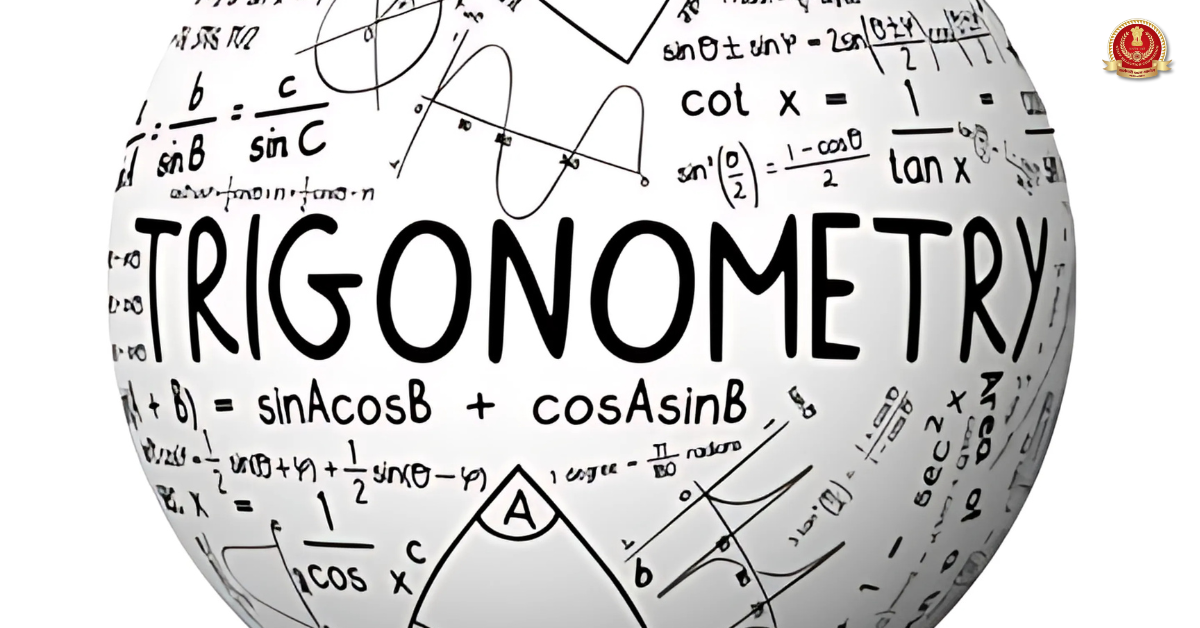The quantitative aptitude section is one of the most challenging parts of the exam. To score well, consistent practice across all key topics is essential. Trigonometry Questions for SSC CGL is an important topic you must prepare thoroughly for the upcoming exam. To help you with this, we have created a blog covering the 30 most important Trigonometry questions for the SSC CGL exam. Attempt these and assess your preparation level.
Common Mistakes Students Make While Attempting Trigonometry Questions
Understanding trigonometry concepts is important, but many students lose marks due to simple avoidable errors. Below are some of the common mistakes students make during exams:
- Misapplying Trigonometric Identities
Students often confuse identities like sin²θ + cos²θ = 1 or sec²θ – tan²θ = 1. One small error here can change the entire answer. - Incorrect Value Substitution
Mistakes are common while substituting standard values such as sin 30°, cos 60°, or tan 45°. These values should be memorized properly. - Wrong Angle Unit Interpretation
Mixing degrees and radians, especially in questions involving π, is a major source of error. Always check the unit before solving. - Ignoring Angle Conditions
Questions often mention whether the angle is acute, obtuse, or between 0° and 90°. Ignoring this can lead to incorrect quadrant signs. - Skipping Basic Diagrams or Triangle Logic
In geometry-based trigonometry, not drawing triangles or ignoring Pythagorean relationships (like a² + b² = c²) leads to confusion. - Calculation and Sign Errors
Small calculation slips, especially in fractions and roots (like √3 or 1/2), can cause incorrect final answers even if the method is right. - Not Revising Formulas Thoroughly
Lack of regular revision causes confusion between formulas like tan²θ = sec²θ – 1 and cot²θ = cosec²θ – 1.
Tips and Tricks to Solve Trigonometry Questions Quickly
Here are some useful tips and tricks to help you solve trigonometry questions faster and more accurately in exams like SSC CGL, SSC CHSL, and Railway Exams:
1. Memorize Standard Trigonometric Values
Know the values of sin, cos, tan, cosec, sec, and cot for key angles (0°, 30°, 45°, 60°, 90°) by heart.
Example table:
- sin 30° = 1/2
- cos 60° = 1/2
- tan 45° = 1
2. Use Trigonometric Identities Smartly
Common identities you must remember:
- sin²θ + cos²θ = 1
- 1 + tan²θ = sec²θ
- 1 + cot²θ = cosec²θ
Apply these identities directly when you see matching expressions.
3. Convert All Angles to Degrees or Radians
Be consistent with units. If a question has π terms, convert them to degrees unless specifically asked in radians.
4. Use Complementary Angle Identities
Remember:
- sin(90° – θ) = cos θ
- tan(90° – θ) = cot θ
These are helpful when angles add up to 90°.
5. Know the Signs of Ratios in All Four Quadrants (ASTC Rule)
- All positive in 1st quadrant (0° to 90°)
- Sin positive in 2nd quadrant (90° to 180°)
- Tan positive in 3rd quadrant (180° to 270°)
- Cos positive in 4th quadrant (270° to 360°)
Also check SSC CGL Maths Syllabus
6. Try Elimination in MCQs
If stuck, plug in answer options in the equation. It may save time rather than solving the full expression.
7. Break Down Complex Expressions
Simplify expressions like (1 – sin²θ) as cos²θ or (sec²θ – 1) as tan²θ to reduce steps.
8. Use Triangle-Based Visualization
For questions involving right-angled triangles, draw a triangle and use a:b:c ratios (like 3:4:5) to solve faster.
9. Practice Frequently Asked Patterns
Trigonometry often repeats question types. Practice questions like:
- Value-based simplification
- Trigonometric equation solving
- Triangle-based angle identification
10. Attempt Mock Tests Regularly
Mock tests help build speed and improve accuracy. Review your mistakes to strengthen weak areas. By applying these tricks, you’ll save time and reduce errors in the trigonometry section of competitive exams.
Practice Trigonometry Questions for SSC Exams
Solve these important Trigonometry MCQs to improve your chances in upcoming SSC exams. These questions are based on exam trends and include identities, values, and standard angles.
Q1. If sin A = 3/5 and A is acute, what is the value of cos A?
A) 4/5
B) 3/4
C) 5/3
D) 5/4
Correct Answer: A) 4/5
Q2. The value of sin² 60° + cos² 30° is
A) 1
B) 1.5
C) √3
D) 0
Correct Answer: B) 1.5
Q3. If tan A = 1, then the value of sin A + cos A is
A) √2
B) 1
C) √3
D) 2
Correct Answer: A) √
Q4. The value of sin² 45° + cos² 45° is
A) 1
B) 0
C) √2
D) 2
Correct Answer: A) 1
Q5. What is the value of tan 60° – cot 30°?
A) 0
B) 1
C) √3
D) 2√3
Correct Answer: A) 0
Q6. If A + B = 90°, then tan A × tan B =
A) 1
B) 0
C) –1
D) 2
Correct Answer: A) 1
Q7. The value of sec² θ – tan² θ is
A) 1
B) 0
C) 2
D) –1
Correct Answer: A) 1
Q8. If sin θ = 12/13, then what is cot θ?
A) 5/12
B) 12/5
C) 13/12
D) 12/13
Correct Answer: A) 5/12
Q9. If tan θ = 3/4, then what is sin θ?
A) 3/5
B) 4/5
C) 5/3
D) 5/4
Correct Answer: A) 3/5
Q10. What is the value of sin 30° × cos 60° + cos 30° × sin 60°?
A) 1
B) 0
C) √3
D) 1/2
Correct Answer: A) 1
Q11. sin 18° × sin 72° + cos 18° × cos 72° =
A) cos 54°
B) 1
C) 0
D) √2
Correct Answer: A) cos 54°
Q12. If cos A = 0.6, then tan A is
A) 3/4
B) 4/3
C) 5/4
D) 3/5
Correct Answer: B) 4/3
Q13. What is the value of sin 60° × sin 30° + cos 60° × cos 30°?
A) 1
B) √3
C) √3/2
D) 1/2
Correct Answer: C) √3/2
Q14. If cot θ = √3, then θ =
A) 60°
B) 30°
C) 45°
D) 0°
Correct Answer: B) 30°
Q15. The value of sin² 30° + sin² 60° is
A) 1
B) 3/4
C) 5/4
D) 2
Correct Answer: A) 1
Q16. tan² θ – sin² θ is equal to
A) sec²θ–1–sin²θ
B) cot² θ
C) cos² θ
D) 1
Correct Answer: A) sec²θ–1–sin²θ
Q17. The value of cosec² A – cot² A is
A) 1
B) 0
C) –1
D) 2
Correct Answer: A) 1
Q18. The angle whose cotangent is 1 is
A) 45°
B) 30°
C) 60°
D) 90°
Correct Answer: A) 45°
Q19. If sec A = 13/12, find tan A.
A) 5/12
B) 12/5
C) 13/5
D) 5/13
Correct Answer: A) 5/12
Q20. The maximum value of sin θ + cos θ is
A) √2
B) 1
C) 2
D) 0
Correct Answer: A) √2
Q21. sin² A + cos² A =
A) 1
B) 0
C) 2
D) 3
Correct Answer: A)
Q22. If tan θ = 1/√3, then θ =
A) 30°
B) 45°
C) 60°
D) 90°
Correct Answer: A) 30°
Q23. The value of sin 90° + cos 0° is
A) 2
B) 1
C) 0
D) √2
Correct Answer: A) 2
Q24. The value of (1 + tan² A)/(1 + cot² A) is
A) tan² A / cot² A
B) cot² A / tan² A
C) tan² A
D) 1
Correct Answer: C) tan² A
Q25. If sin θ = cos θ, then θ =
A) 30°
B) 45°
C) 60°
D) 90°
Correct Answer: B) 45
Q26. Which of the following is equal to sec² θ – tan² θ?
A) 1
B) 0
C) sin² θ
D) cos² θ
Correct Answer: A) 1
Q27. What is the value of sin 60° – sin 30°?
A) (√3–1)/2
B) 1/2
C) 1
D) 0
Correct Answer: A) (√3–1)/2
Q28. If A is acute and sin A = 5/13, find cos A.
A) 12/13
B) 13/5
C) 5/12
D) 1/2
Correct Answer: A) 12/13
Q29. If A = 45°, what is the value of tan² A – sec² A?
A) –1
B) 0
C) 1
D) 2
Correct Answer: A) –1
Q30. The value of sin 30° × cos 60° + cos 30° × sin 60° is
A) 1
B) 1/2
C) 0
D) √3/2
Correct Answer: A) 1
Also attempt SSC CGL Practice Quiz
Trigonometry for SSC CGL 2025- FAQs
Ans: Key identities include sin²θ + cos²θ = 1, 1 + tan²θ = sec²θ, and 1 + cot²θ = cosec²θ.
Ans: Use sin(90°–θ) = cos θ and tan(90°–θ) = cot θ directly to simplify expressions.
Ans: Avoid mixing up identities, mis-substituting standard values, and skipping Pythagorean checks.
Ans: Typically 5–10 questions on identities, values, and expressions appear in the Quantitative Aptitude section.
Ans: Plug in the options into the given trigonometric equation to see which one holds true.
- RBI SO Syllabus and Exam Pattern 2025 for Grade A and B
- RBI SO Eligibility 2025, Check Qualification & Age Limit
- RBI SO Exam Date 2025, Check Phase 1 Schedule for Grade A/B
- RBI SO Apply Online 2025 Before 31st July for 28 Vacancies
- RBI SO Notification 2025 Out for 28 Vacancies of Grade A & B
- Free SSC CHSL Topic Wise Tests for English, Quant & More, Attempt Now

Hello, I’m a content writer working at Oliveboard. I focus on creating blogs, articles, and educational content that’s simple, clear, and saves time for readers. I believe in writing that adds real value without overcomplicating things. I also have strong knowledge of banking and government exams, which helps me create content that is both accurate and easy to understand. With experience and consistency, I aim to make preparation smoother for every learner.
